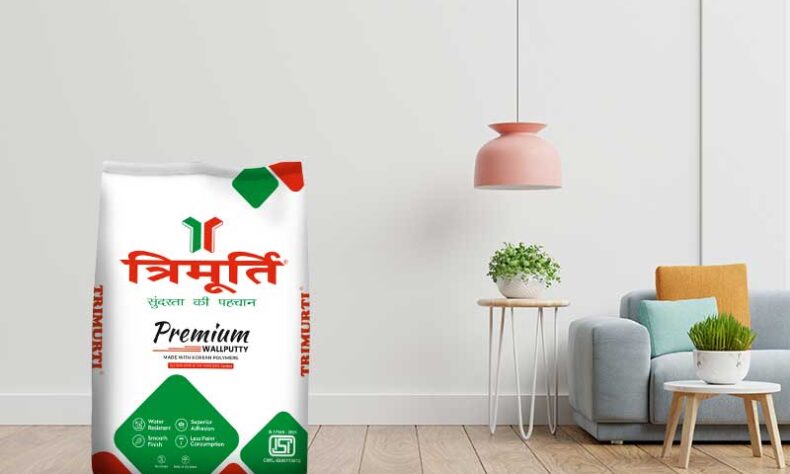
Construction and renovation projects require the surfaces of the walls and tiles to look as smooth and as flawless as possible. Of the several products that are involved in this process, two of the most important ones are the wall putty and grouting powder. In addition to being esthetic, these materials also improve the durability and wear resistance of the surfaces they cover. In this article, the concern is to discuss the significance of using
putty on wall and how to apply it, as well as the fact that grouting powder is crucial for finishing tiled walls.
Why should Putty be applied on wall surfaces
Putty applied on wall surfaces plays an important role in providing a surface for painting or other surface finishing measures. Conversions, cement, and bricks commonly used in construction give the walls an irregular surface, cracks, or minor defects. A spread on these uneven surfaces assists as applying putty leads to making a flat surface ready to take paint or wallpaper. Failing to perform this step means that flaws would be evident and the look of the wall far from satisfactory.
Besides providing a levelled surface to hang pictures and frames, putty on walls also serves as a shield. It acts as a barrier to water penetration and also helps in reducing incidences such as dampness, mould growth or paint peeling off the wall. This barrier also helps the paint stick better to the surface and does not peel off easily throughout its period of usage. The putting of putty is very important since walls after painting have to be attractive as well as protected for a long time.
Selecting the right Putty for your walls
There are two main types of grouting powder: sanded and unsanded. The sanded grouting powder has sand within it and is suitable for wider joints, joints of at least 1/8 of an inch wide. The sand in the mixture is added to increase the strength of the grout to ensure that it does not crack easily. Sanded grout can be used for tiles that are more spaced apart from each other and vice versa, it is suitable for floors and outdoor surfaces. The unsanded grouting powder is used for the small joints and small and smooth surfaces as compared to sanded grouting powder. It is more package-friendly and less likely to produce bubbles or air pockets in the crevices, so it is more appropriate for flat surfaces, such as walls, countertops or spaces with smaller gaps in between tiles. Selecting the proper kind of grout is crucial in enhancing the longevity and aesthetic of the surface with tiles.
How to apply Putty on the wall: A comprehensive procedure
The process of applying putty on the wall surfaces can be described as simple but requires much attention. The initial preparation involves washing the wall with water and, where necessary, detergents to remove dust and similar substances. Any holes and cracks should be patched and brought to a flat surface before applying the putty.
When the surface is to be treated, the putty is diluted with water to make it a paste. With the use of a soft putty knife or trowel, the skim coat mixture is spread across the wall in the form of thin layers. It is a good idea to apply it evenly, as layers that are too thick should be avoided because they can crack or dry unevenly. Once the first coat is laid, it requires several hours to dry up before applying another layer of the compound. In most cases, at least two layers are applied with each layer being sanded to produce a smooth finish. When the final layer has been applied and allowed to dry and then sanded down, the putty wall is now available for painting or wallpapering.
Advantages of using putty for a long-lasting finish
Some benefits that come with the application of putty walls are as follows: Holes that were initially on the walls get closed and this improves the durability and longevity of the wall finishes. There is enhanced paint adhesion which means that the paint cannot easily chipped or peel off the surface. The flat finish provided by the putty enables the paint to stick better hence providing a better finish and duration of paint work.
It is also useful to prevent direct contact with moisture, which is necessary in the home, for instance, in the kitchen or the bathroom. Putty can contain small pores that hinder moisture from penetrating the wall surface, thus minimizing the chances of mould, mildew, or water damage. This helps to prolong the life of the paint further and also helps in improving the hygiene of the space as well as the aesthetics.
The contribution of grouting powder to tiled areas
Whereas putty helps in preparing the wall surface, grouting powder on the other hand is vital in fixing and sealing tiled surfaces. The cement-based grouting powder is applied on the exposed tiled surface to eliminate the gaps or joints between tiles and provide an even and smooth finish. It also enhances the strength of the tiled surface, immobilizing the tiles and preventing the penetration of water into the gaps between the tiles.
The grouting powder is even paramount in areas with tiled floorings open to early instances of water exposure, including showers and kitchens. Grouting, which means the application of material between the tiles and spacers, seals the gaps and any water getting into the surface, such as through condensation, can cause problems such as mould formation or a breakdown of the adhesive bond between tiles and the surfaces they cover. Besides the functional one, the use of the grout adds to the appearance of the surfaces tiled making the joints between the cove tiles and tiles look neat and finished.
The right grouting powder to use with tiled surfaces
There are two main types of grouting powder: sanded and unsanded. The sanded grouting powder contains small gritty particles of sand in it and is recommended for large joints of width more than 1/8 inch. Especially the sand helps to strengthen the grout since it is self-curing and does not crack easily. Sanded grout is preferred especially if there are large tiles and or the tile work is for floors or exterior applications.
Unsanded grouting powder is for small joints and softer work surfaces, for example, tiles with small spaces in between them. As you will see it is easy to apply and more fitting for the walls, countertops or areas with small gaps in between tiles. One must however note that it is very important to select the right form of grout to guarantee that it will last long and also create a good impression on the tiled surface.
Use of grouting powder for polished concrete floor
The practical formulation of grouting powder that is used in gasket applications is not very complicated all that is needed is meticulous adherence. When the tiles are laid down the cement for use as grout is prepared by adding water to it to form a grout. Using a grout float, the mixture is applied over the tiled area and it is forced into the crevices between the tiles. There should be equilibrium to all gaps that are created, making sure there are no pockets of air or spaces.
Any seepage of grout that is beyond the face of the tiles is to be wiped clean when still wet with a damp sponge. This helps avoid the premature bonding of the grout with the tiles to give a finish that also doesn’t leave a residue. After the application of the grout, it is allowed to cure for 24 to 48 hours depending on the type of grout used and the condition under which its curing is done. When fully cured the grout fawns a strong waterproof barrier that holds the tile from below and does not allow any seepage through the joints.
To sum it up, putty for implemented wall surfaces and
grouting powder for tiled surfaces are two materials which must not be omitted in rendering a smooth, well-polished and good-looking surface. These are the most common forms of application as they afford the base for decoration in any room or even hold tiles firmly for efficiency and quality appearance. When it comes to putty and grout, understanding how to use them correctly is very important and so is appropriate care which will help walls and tiled areas to stay as good as new in the many years to come.
 Construction and renovation projects require the surfaces of the walls and tiles to look as smooth and as flawless as possible. Of the several products that are involved in this process, two of the most important ones are the wall putty and grouting powder. In addition to being esthetic, these materials also improve the durability and wear resistance of the surfaces they cover. In this article, the concern is to discuss the significance of using putty on wall and how to apply it, as well as the fact that grouting powder is crucial for finishing tiled walls.
Construction and renovation projects require the surfaces of the walls and tiles to look as smooth and as flawless as possible. Of the several products that are involved in this process, two of the most important ones are the wall putty and grouting powder. In addition to being esthetic, these materials also improve the durability and wear resistance of the surfaces they cover. In this article, the concern is to discuss the significance of using putty on wall and how to apply it, as well as the fact that grouting powder is crucial for finishing tiled walls.
 Construction and renovation projects require the surfaces of the walls and tiles to look as smooth and as flawless as possible. Of the several products that are involved in this process, two of the most important ones are the wall putty and grouting powder. In addition to being esthetic, these materials also improve the durability and wear resistance of the surfaces they cover. In this article, the concern is to discuss the significance of using putty on wall and how to apply it, as well as the fact that grouting powder is crucial for finishing tiled walls.
Construction and renovation projects require the surfaces of the walls and tiles to look as smooth and as flawless as possible. Of the several products that are involved in this process, two of the most important ones are the wall putty and grouting powder. In addition to being esthetic, these materials also improve the durability and wear resistance of the surfaces they cover. In this article, the concern is to discuss the significance of using putty on wall and how to apply it, as well as the fact that grouting powder is crucial for finishing tiled walls.






